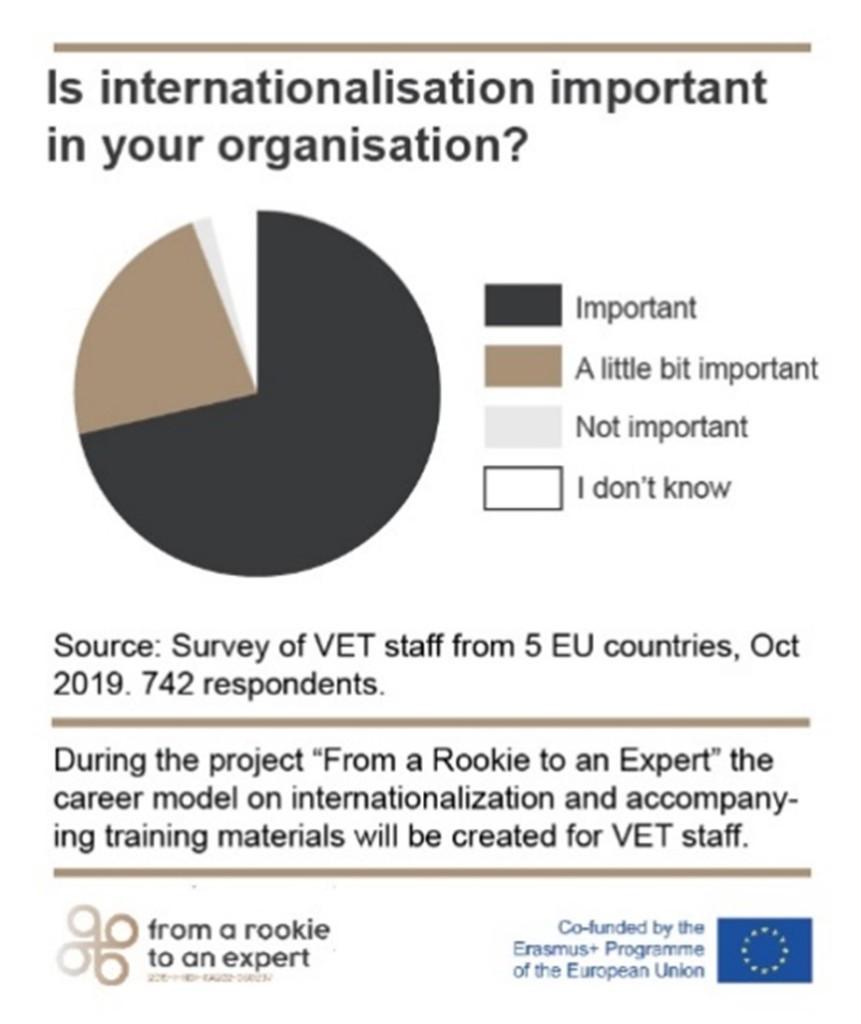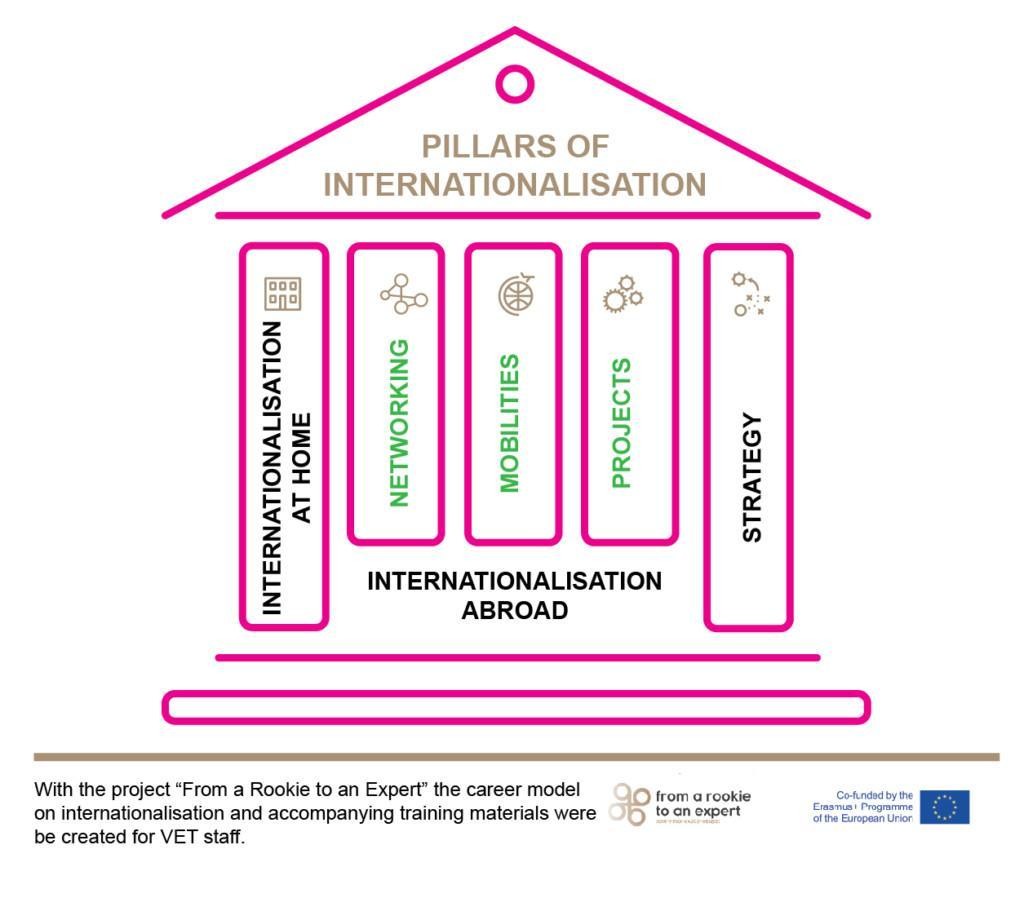Intro to internationalisation
Module 1: Rookie level
So.. you’re a newbie… learn here how to start your journey in internationalisation.
Rookie level
Intro to internationalisation
So.. you’re a newbie… learn here how to improve your international skills as a staff member of a VET school.
Watch how Andres from Estonia started his journey.
If you cannot see the video below, please allow all website cookies.
Rookie
Staff member who is aware of internationalisation in VET and international activities in which his or her organisation is involved in, or in the case where the organisation is not involved in such activities what are the available possibilities.
This module is for you if…
You are not aware of what internationalisation is and you want to know more about the internationalisation opportunities in VET.
What are you going to learn
After this module you will be able to support your colleagues in organizing international activities at school.
Training Topics
Topic 1: Basics of Internationalisation
What is Internationalisation?
There is no full agreement or exceptionally good definition for the word “internationalisation” yet. There are still many arguments about that and about what is the differences between globalisation and internationalisation, but the main idea of internationalisation in vocational education is to offer high quality vocational education which makes student competitive in the global labor market.
It does not matter what tools are used for internationalisation; the only important thing is that after graduation students have the main globally needed skills. For example one listing comes from Dr. Tony Wagner, co-director of Harvard’s Change Leadership Group:
- Critical thinking and problem-solving
- Collaboration across networks and leading by influence
- Agility and adaptability
- Initiative and entrepreneurialism
- Effective oral and written communication
- Accessing and analyzing information
- Curiosity and imagination
But these skills can be more easily obtained if we use next to formal learning in addition with all other available methods. Such as: learning/working in a multicultural environment, mobilities abroad, learning through communication/playing/travelling, etc.
One of the best possibilities for your organisation could be the EU Erasmus program:
Watch the video on what internationalisation means to different people:
Benefits of internationalisation
There is no doubt that internationalisation brings many benefits to all involved. It is clear that there will be better employment possibilities and a more successful working life. But it also brings a better understanding of the world, friends, interesting challenges, and a new perspective on everything you do.

But even so, it is difficult to start. There are so many doubts like “Am I good enough?”, “What if I can’t make myself understood?”, etc.

quality manager, Kuressaare Ametikool, Estonia.
“Internationalisation in vocational education institution enriches studies, develops the organization and ensures innovation.”
“Praise Erasmus for giving me the opportunity to come to France to study to be a confectioner I landed (not quite by chance) in the workshop of Florian, the best confectionery in Nice, France, where they make super-flavoured candied fruits, wonderful glass sweets and chocolates flavoured with crystallised flower essences.
The team is very friendly, and the work goes smoothly: last week we handmade 780 bars of chocolate in one day! I’ve gained a huge amount of new knowledge. I often think that I’d like to start making sweets like these when I return to Estonia from my traineeship.”

Pastry student, Kuressaare Ametikool, Estonia.
Topic 2: Different Pathways of Internationalisation
It was mentioned earlier that it does not really matter which tools you choose to use for the internationalisation process.
But please allow us to separate those tools here into two bigger categories: Internationalisation at home and Internationalisation abroad. It is easier to start from internationalisation at home.

2.1 Internationalisation at home
Shortened to I@H, it involves all activities which are made towards developing international skills without leaving your home country. So, learning languages is I@H, getting to know the national cuisine of a foreign country is I@H, receiving foreign guests in your school/home is I@H, visiting a multicultural company is I@H, etc. So as you can see, it can be whatever involves expanding your horison and helping you better understand other cultures.
It is well explained in this one minute video on Youtube.
Need some more simple ideas where to start and what to do? Here are some examples:
- Using international cases/examples during lessons in class
- Asking some foreign person to your lesson to talk about his/her country
- Hosting and interacting with international staff
- Integrate language training into professional studies
- Supporting a colleague in organizing a tour at school for international guests
- Supporting a colleague in organizing promotional days/events – e.g.: Erasmus Day
- Attending meetings or other events related to internationalisation within the organisation
2.2 Internationalisation abroad
As you may have already guessed, internationalisation abroad (I@A) involves all activities which help you to develop your international skills via going/staying abroad. It gives you an advantage if you have experienced some I@H activities before you take your first trip abroad. For example: if you have taken language training, or met some foreign colleagues, or you are familiar with internationalisation activities in your organisation, you may already feel more secure when you are going to visit an institution abroad.
There are four main things we have to talk about under this section: networking, mobilities, partnership projects, internationalisation strategy.
2.2.1 Networking
We all do networking every day. It means that we are communicating and exchanging the information with those who have similar interest or background, or they do have similar profession and we do it because we can get/offer help to each other.
If you’re a fan of terms you can read more about the terminology of networking:
But when we talk about international networking in VET it basically means that we are creating professional relations with our colleagues from abroad. Sometimes these are small networks (like communication between two VET schools), sometimes those can be really big (like hundreds of institutions which are gathered under one non-profit umbrella institution). And why we do it? Mostly to:
- share experiences and challenges
- gain new ideas, new teaching methods
- be innovative and informed about trends within your professional area
- compose new common/international training material or even curriculum
- grow our professional knowledge and motivation
- arrange different international activities/events etc
Some umbrella networks are smaller and unite narrower group of schools. For example, AEHT which connects European Hotel and Tourism VET schools or INNOTECS which connects technical education providing VET schools. And then there are the big ones we mentioned before like EfVET – which is one of the leading European-wide professional associations which has been created by, and for, Vocational Education and Training (VET) providers. EfVET’s policy and strategy are formulated by its member colleges and VET institutions. It collaborates with but is independent from all government and funding bodies.
The benefit of belonging to some bigger network like EfVET is that they are also sharing the last news at European level, you can disseminate your activities and you can also find more easily new contacts and most relevant help in case you need it.
In many cases you don’t have to move physically to do networking, you can communicate virtually on platforms or via e-mail or use any other medium but believe – it’s much more fun with mobility.
2.2.2 Mobilities
The most well-known and the most popular internationalisation activity for most schools is without doubt mobility abroad. Staff can apply for shorter (from 2 days) or longer mobilities. As we already mentioned at the beginning of this training material, the easiest way to get funds for mobilities is Erasmus+ program. The aim of mobilities can be study visit to another college to get innovative ideas on how to arrange better the studies to solve specific topic in your organization or longer mobility (even few months) as job-shadowing/teaching/practicing in another college or organization. The reason for mobility could also be attending a training course or conference or preparatory visit to meet the company where your students are going to do their work-placement. And there are more options of course.
Mobilities can be also virtual or blended mobilities. Virtual mobilities are good for those who do not want or cannot leave their home country. For sure the virtual mobilities are very sustainable way to meet your goals. For sure the virtual mobilities are very sustainable way to meet your goals.
Blended mobilities offer the possibility to gain skills and knowledge in both ways – you do part of your mobility in virtual environment and the other part you do abroad, which is very good option in these COVID-19 days. You start with your mobility now virtually and will finish it with real mobility when they realise the travelling restrictions.
Check out the video on Erasmus+ Staff training mobility by Sheffield University.
Video: Erasmus+ Staff training mobility by Sheffield. University
Taking part in mobilities is also popular among students. Students of vocational schools are usually doing their work placement at companies.
You can show this video to your students to give to them first expression of mobility.
Youtube: If Erasmus had a trailer
We have some tips for you about taking part in mobility:
- If possible, go on your first trip with somebody who has done it before.
- Prepare yourself: travelling information, basic country information, basic expressions in destiny country language
- Explore beforehand your hosting organization
- Be ready to present yourself and your sending organization.
- Study all materials which have been sent to you by your host organization
- Contact the host organization before your trip.
Owww …. I´m afraid we missed something. There are some terms you should know!!! Check the Erasmus Glossary
To Erasmus Glossary at ec.europa.eu.
By the way – when we are in mobility then we usually do networking.
Pretty often mobilities and networking lead to international projects.
There is another video explaining the Benefits of mobilities:
ROI-MOB in EU VET mobility project: introduction video on Youtube.
2.2.3. International projects
In many cases when you are networking you are end up with the conclusion that common problem/challenge needs more work and input from all parties. And it may also need some additional funding (we know that VET is underfinanced in most countries) to pay people for all this additional work or to arrange meetings and mobilities.
Luckily, EU offers its help to improve the quality of education via several funding bodies and there are several types of projects which are funded under many measures. For example, your school and others from your network have a common interest in creating innovative training material. You have an idea, and you have partners, but no money. Then you can apply for example the Erasmus program KA2 strategic partnership project:
Video: Erasmus+ strategic partnerships in education
If you are not sure whether your home country is eligible for Erasmus funding or you want to know with which countries you can create partnership, please check the Erasmus webisite.
Easiest way to get know your possibilities about Erasmus program is to contact your country’s National Agency and ask for help in finding the correct one. Or if there are few partners from neighbouring countries who want to improve their region in an innovative way, they also can apply for Interreg program.
Read more about the Interreg program from their site.
But there are many more funding programs like Nordplus in Nordic countries and so on. You can find full list of call of tenders for financing your education and training from the link below.
List of resources at ec.europa.eu.
There is just one thing you should keep in mind – most funding programs accept applications just from juridical bodies not from individuals, for example if you are teacher and want to take part in mobility you can´t directly apply Erasmus program – you have to do it through your school.
But before applying for funds you must get know what is this SOMETHING you need to do, with whom, when why…. And this “something” is usually defined in school strategies or development plans or other similar documents.
More and more organizations have also worked out their internationalisation strategies.
2.3 Strategy
Even it is thought that word “strategy” sounds like something extremely complicated, dull, and painful to create, it is pretty useful thing. Creating the internationalisation strategy helps your school to create a pathway towards its goals. It`s actually just mapping your possibilities, resources, target groups and setting the deadlines etc.
In a simplified way – The internationalisation strategy describes which international activities and how will help your organization to achieve its goals.
Practical tasks
- Get to know how internationalisation is organized in your organization: read internationalisation strategy or other development documents to get an idea what are the objectives of your organisation. If you do not have any, please contact some colleagues from other schools.
- Meet the staff of your organization and ask for the EU and other international projects managed by your organization or contact, for example your National Agency coordinating Erasmus program.
Find your National Agency here. - Ask for networks and international organisations in which your organization is involved.
- Discover the handbooks and other materials your organization has published over the years for example project websites, stories of mobilities
- OR contact some Erasmus accreditation holder to talk about good practices
- OR Check out the possibilites of EU funding at europa.eu.
Read more:
- GO International – A practical guide on strategic internationalisation in vocational education and training
- Internationalising vocational education and training in Europe
- Internationalising of VET in Finland – Three tools information for schools to prepare their Erasmus+ applications. Europe’s online platform for school education
- Erasmus+ Oppurtunities – Three tools and information for schools to prepare their Erasmus+ applications. Europe’s online platform for school education
- Webinar at Youtube: Internationalisation at home: what is it and how can it contribute to an international experience?
Show your skills and earn your open badge here

The European Commission’s support for the production of this publication does not constitute an endorsement of the contents, which reflect the views only of the authors, and the Commission cannot be held responsible for any use which may be made of the information contained therein.